Whilst many fans had recognised the Spanish national team’s pedigree in major international tournaments ahead of Euro 2024, very few would’ve predicted their passage through the ‘group of death’ in such a dominant fashion.
For his first major tournament as head coach, Luis de la Fuente’s multifaceted tactics have allowed Spain to progress to the round of 16 relatively unscathed, having been afforded the luxury of multiple personnel switches to keep their opposition guessing.
Spain topped Group B in a dominant fashion, progressing to the knockout rounds without conceding a single goal and racking up a perfect nine points for just the second time since 2008, where they inevitably went on to be crowned champions!
Having asserted their dominance in this competition, they have been rewarded with the trickier side of the knockout bracket, with the likes of France, Germany and Portugal standing in their way of a spot in the final.
However, having observed Spain’s ability to inject new life and ideologies when facing different opponents across the group stage, they certainly demand respect and will be a team to be feared in the latter stages.
This tactical analysis and scout report will begin to highlight just how de la Fuente’s side has set the standards, with their attacking flair and ability to delve from the preconceived identity from years gone by.
Our analysis will also look ahead to Spain’s clash with Georgia in the round of 16, with insight into how they can potentially be exploited, with their tactics not being 100% perfect despite their incredible record thus far.
La Roja are on a roll, with excellent team cohesion and all but one of their players being able to get much-needed game time under their belts.
But will their fine form continue as we approach the business end of the tournament?
Breaking the press
Spain have asserted themselves as an excellent side when breaking the opposition press, finding multiple avenues to attack the space found when exploiting the defensive structure of their opponents.
Their current crop have highlighted just how effective they can be when speeding up their attacking sequences, using incredible tempo as opposed to their usual ball dominance and grinding out opportunities with their intricate, short passing moves.
In fact, their encounter with Croatia marked the end of a 16-year streak in which Spain had achieved more possession than their opposition, finally ending their 136-match run with just 47% in the 3-0 victory.
The monumental event marks a switch in approach for de la Fuente, with a desire to increase Spain’s verticality and become more direct.
Throughout the tournament, Spain have persisted with building out in the 2-5-3, focusing on a triangle between both central defenders and the ever-present Rodri at the base of the Spanish midfield.
The two full-backs have been deployed fairly wide but not too advanced initially to bait opposition wide players to press intensely and create space through the channels.
The two advanced midfielders, Fabián Ruiz and Pedri, have the license to roam between the lines and interchange where they see fit, ultimately providing for the Spanish front three, with their wingers showcasing their 1v1 ability to great effect this tournament.
Spain’s direct nature was perfectly depicted by their opening goal against Albania, utilising their central defenders’ progressive and technical proficiency to break the lines.
After the Albanian press had initially worked hard to negate passing outlets for Vivian, they were slow to shift across and stop Laporte from picking out the darting run of Olmo through the half-space.
The Leipzig player was subsequently able to thread a perfectly weighted ball through to the inverting Ferran Torres, who could guide the ball into the far corner.
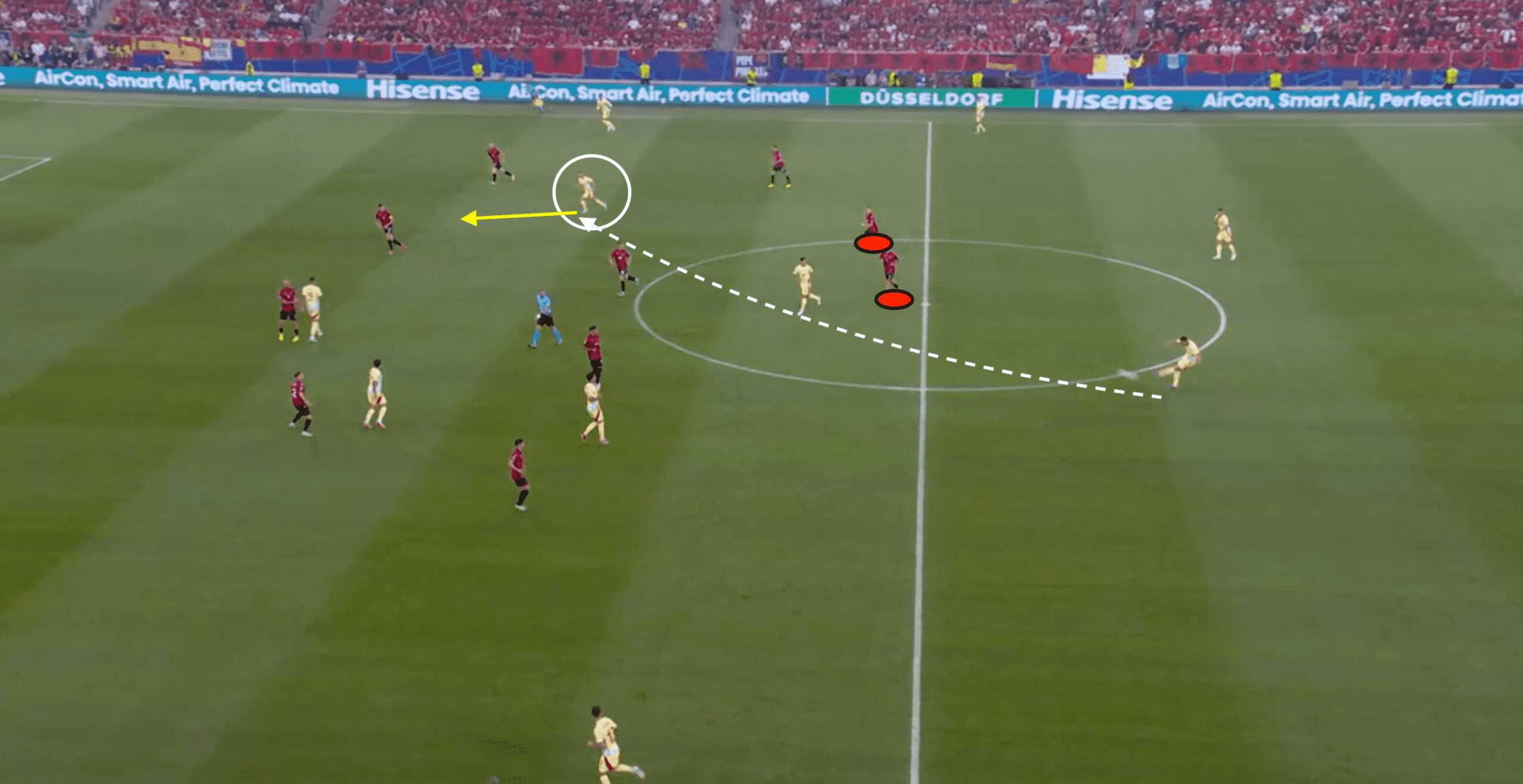
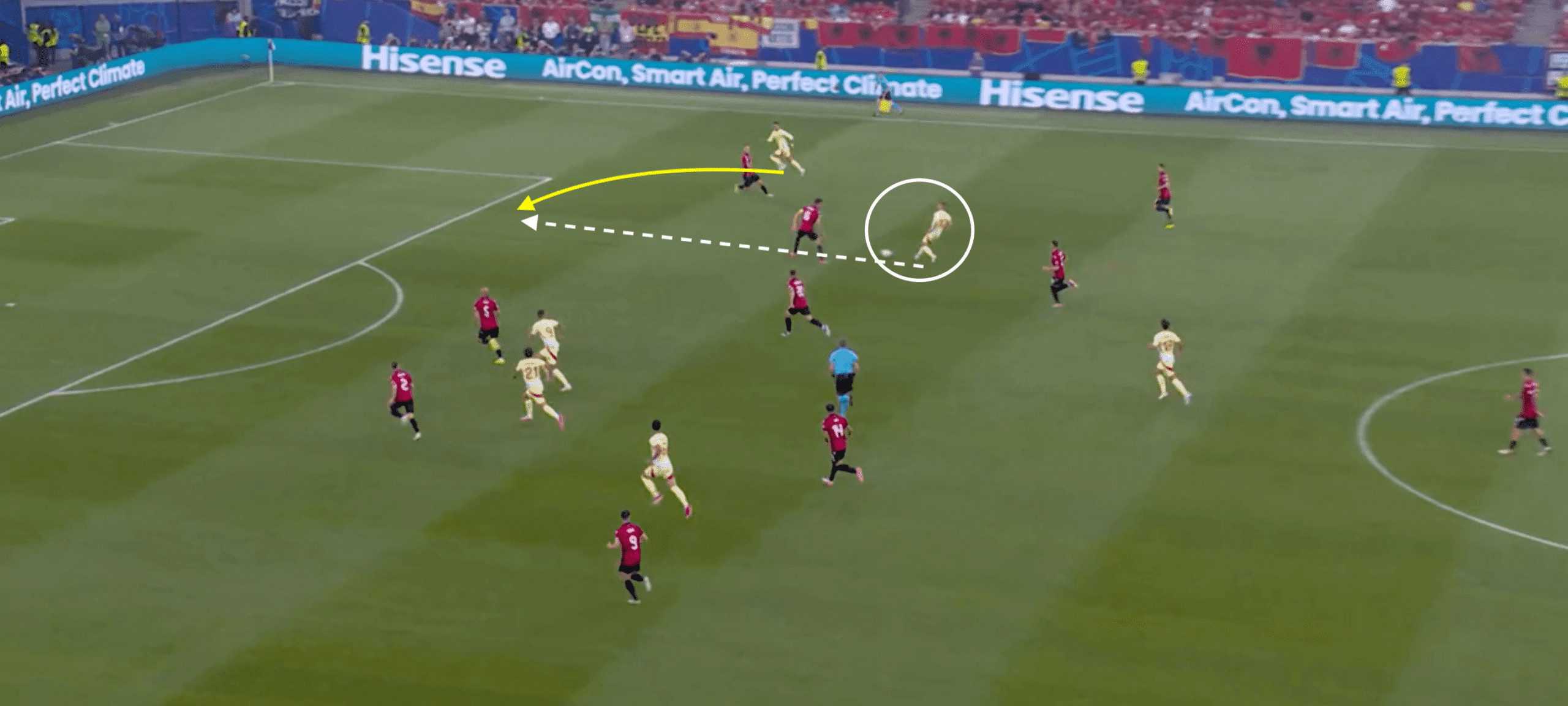
Against a sterner press, Spain have been able to cut through their opposition when both central defenders are occupied.
When playing Italy, Spain had to deal with Barella stepping up from the midfield line to press in a 4-4-2 shape, accompanying their lone striker.
This consequently forced Rodri to receive increased pressure, with one of the central midfielders jumping to shadow the Manchester City midfielder, well aware of the progressive quality he provides.
Crucially for Spain, with Fabián dropping into a double pivot to support Rodri, the Italian midfield were forced to follow and found themselves drawn all out of shape, leaving Pedri as the free man to roam between the lines as the key outlet.
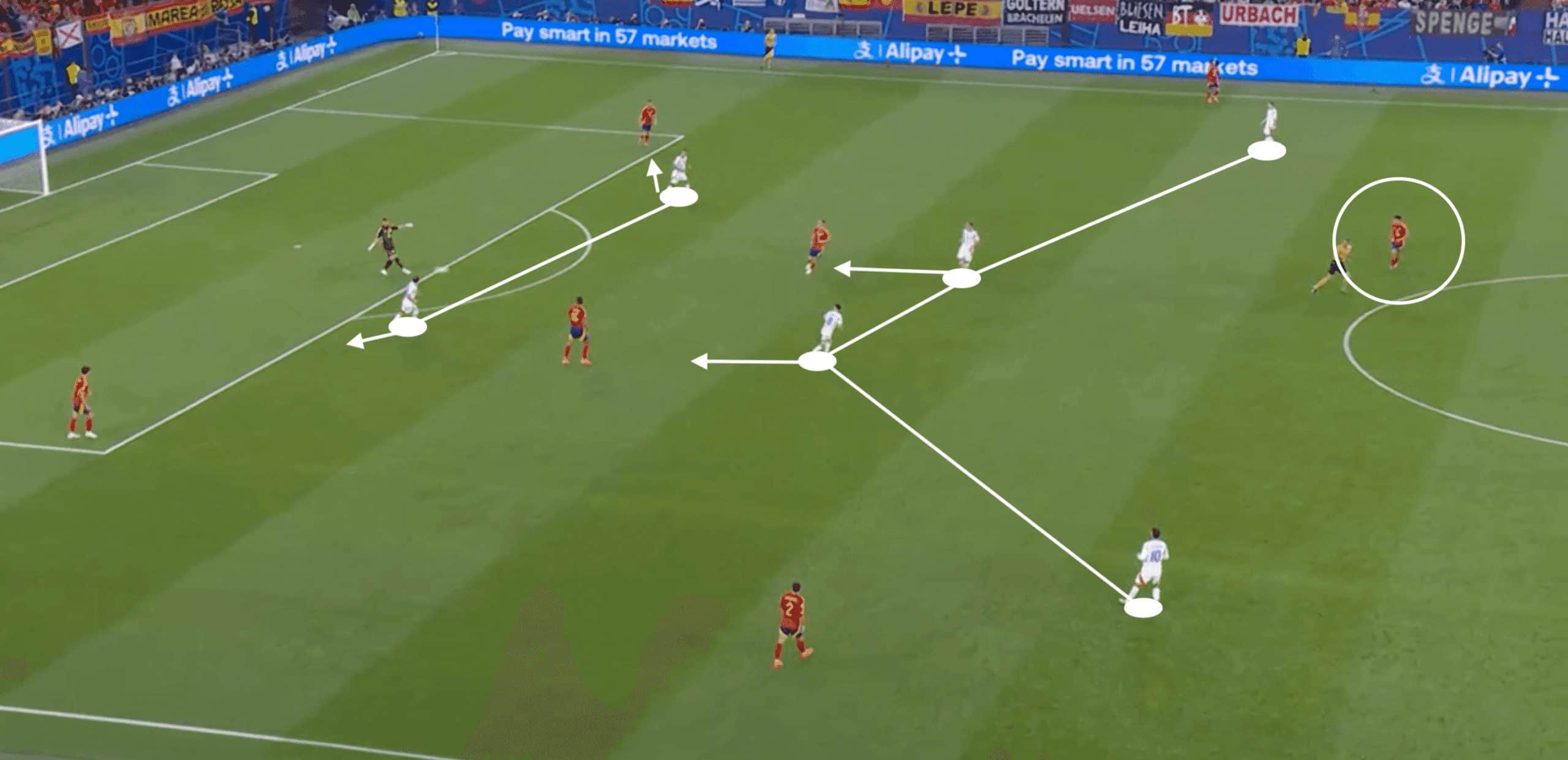
In this example, Simon’s lofted ball completely bypassed the middle third and exploited the aforementioned space, with Frattesi and Jorginho being drawn forward.
The deeper movement of Morata signifies just how effective his link-up with Pedri can be, even though it proved fruitless on this occasion.
There were also occasions where Italy deployed Jorginho as the holding midfielder in a 4-1-4-1 in an attempt to shadow the movement of Pedri behind the Italy midfield line.
However, Jorginho really lacked the necessary mobility to keep up with Pedri’s electric movement, and Italy failed to negate his ability to gain possession.

The relationship between Spain’s attacking midfielder and striker has yet to be fully unleashed, even though the two have been incredibly effective in manipulating the opposition’s defensive line.
Pedri’s ability to find space has often resulted in one of the central defenders having to be aggressive and press the Barcelona superstar when he has his back to goal.
This then results in isolations across the forward line, with the superior movement of the Spanish forwards causing chaos.
Riccardo Calafiori was consistently forced out of his desired position, but in this example, we see Bastoni forced out and leaving ample room for Morata to run in behind.
Had Pedri been able to thread a pass through or provide Nico Williams with a quicker opportunity to combine with the forward, Spain would’ve been presented with an excellent 1v1 opportunity on goal.
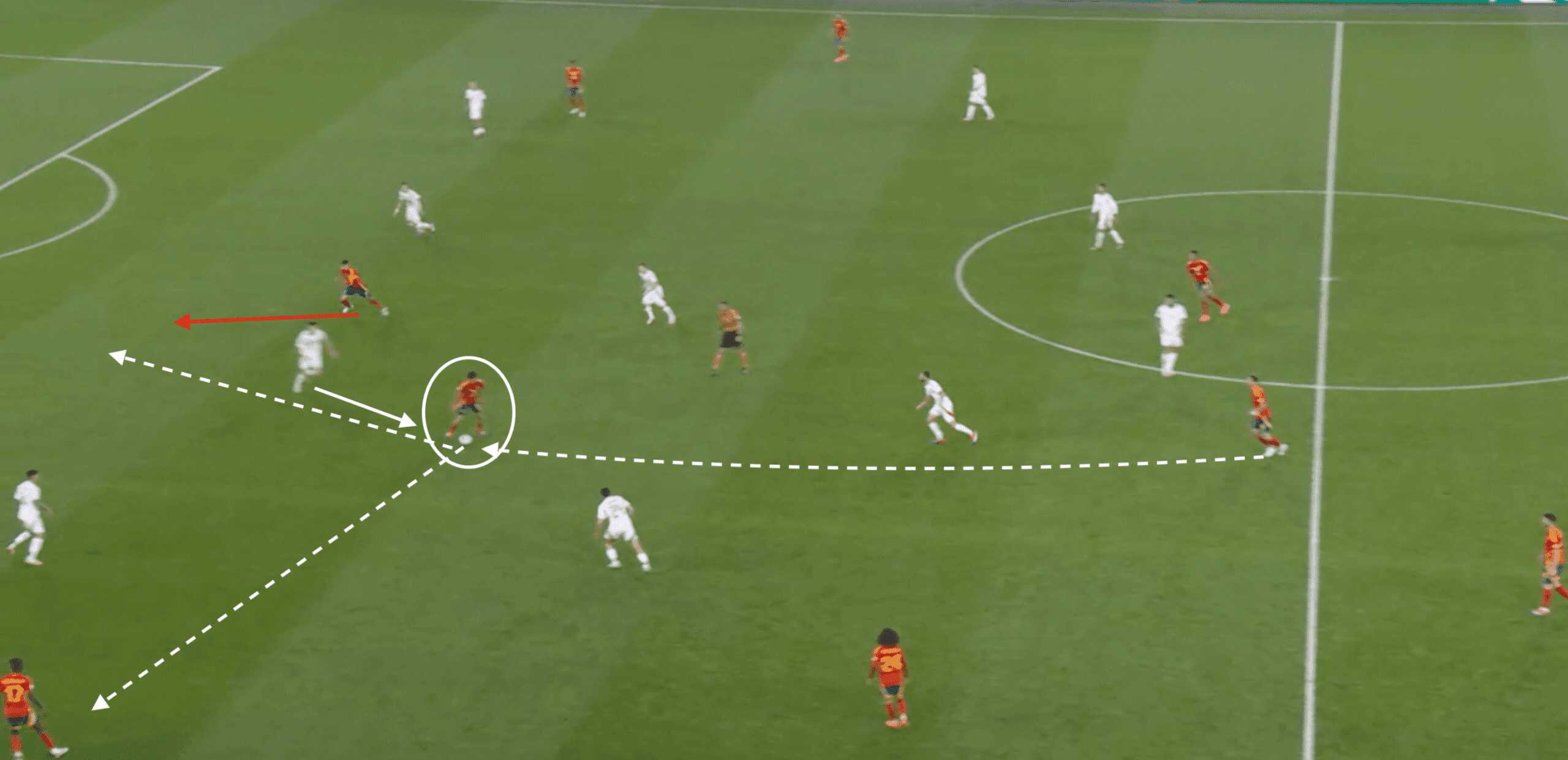
Williams out wide
Whilst Lamine Yamal has been receiving plaudits as the youngest participant in the history of the European Championships, it has been Spain’s threat on the opposite flank which has equally sparkled throughout the tournament.
Athletic Club’s Nico Williams has formed an impactful partnership with Marc Cucurella on the left side of Spain’s attack, relishing his opportunities to drive at opposing defences with his technical proficiency and alarming speed.
With Carvajal being slightly more reluctant to join the Spanish attack due to his ability to drop into a three-man rest defence, Cucurella has been given the freedom to stretch the width of the opposing defence and allows Nico Williams to drift inside through the channels.
It is fair to say that Nico Williams had terrorised Giovanni Di Lorenzo in the first half with his quick feet and ability to penetrate space in behind.
This forced Bastoni to shift across and cover the Spanish forward when he occupied more central areas when inverting off the left wing, allowing Di Lorenzo to cover Cucurella out wide.
Not only did this allow Morata to once again find himself in an isolated position against Calafiori through the centre, but it also gave Williams an even more favourable matchup, using his superior agility to burst past Bastoni and into the penalty area.
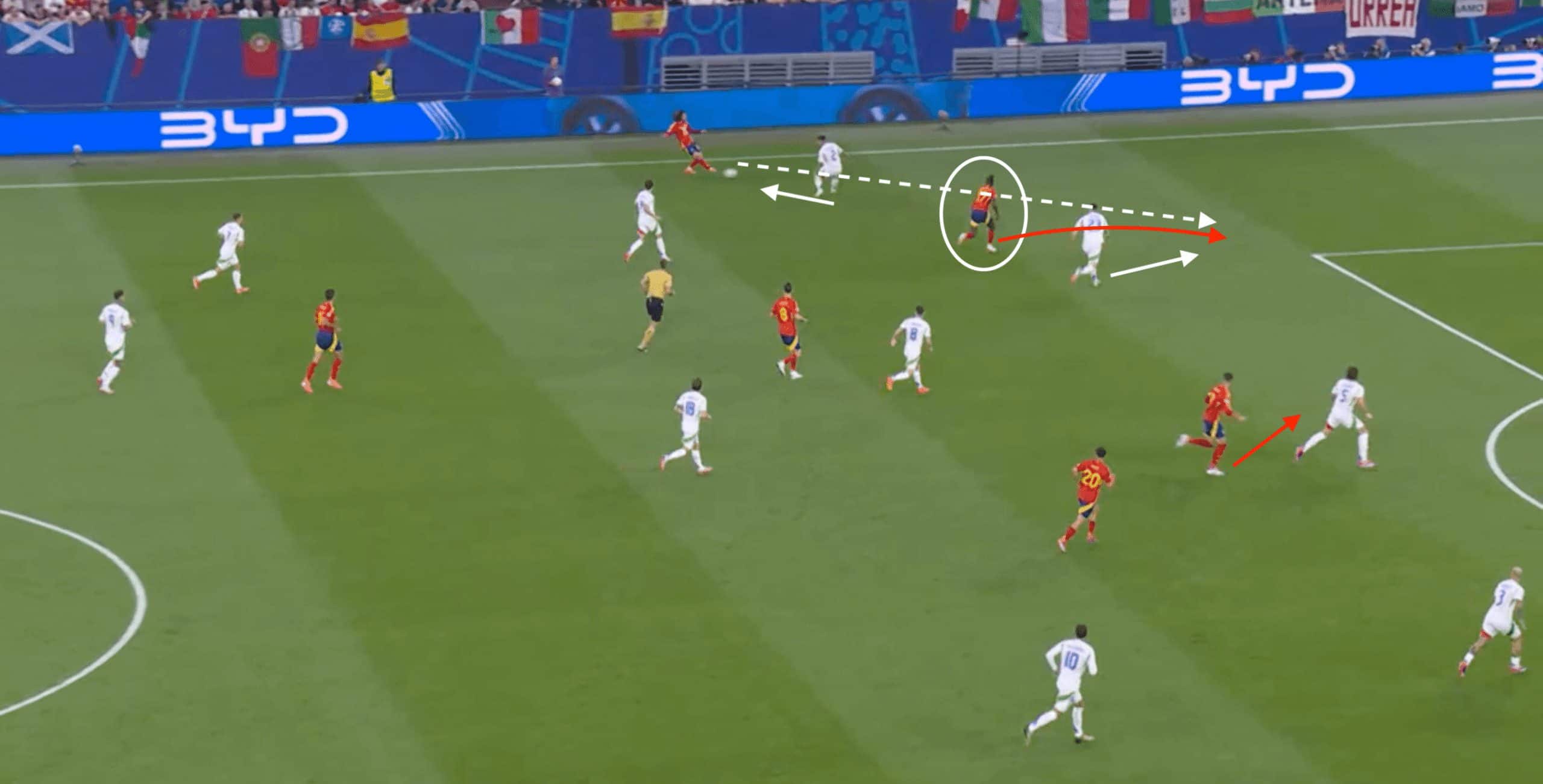
The critical moment of the match actually occurred as a result of intelligent off-the-ball movement from Cucurella.
His underlapping runs had consistently caused the Italians a world of problems, being used to isolate Williams in the first half but also to combat Italy’s desire to double up on Williams with the introduction of Cambiaso in the second half.
Cucurella was able to block the run of Cambiaso when coming back to the ball, once again allowing Williams to go toe-to-toe with Di Lorenzo and beat his man to the byline, flashing the ball across the box, which Calafiori regretfully turned into his own net.
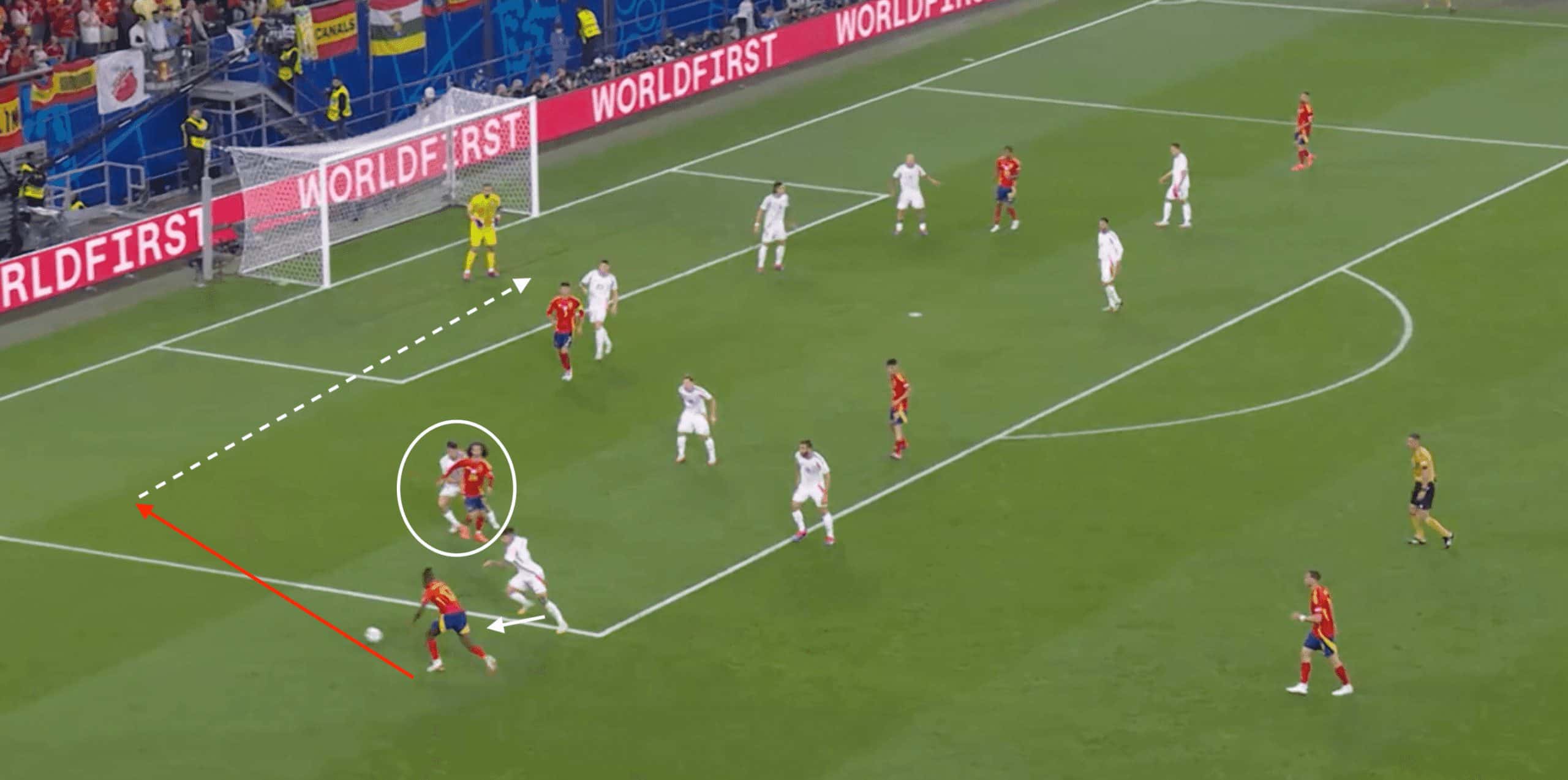
Spanish frailties
After dominant performances against Italy and Albania, Spain won 3-0 against Croatia, highlighting some of their most prominent frailties.
The scoreline perhaps glossed over some of the moments in which Spain looked particularly weak in the defensive phase of play.
Matching the increased tempo that Spain have strived for in the attacking phase, this de la Fuente team aims to press high and exerts a huge amount of effort counter-pressing.
We see Spain’s wide forwards come central without the ball, forcing the opposition to play towards the flanks where both Cucurella and Carvajal can remain tight to their opposing winger.
This man-for-man press worked a treat against Italy, with the Italian wing-backs backs often resorting to long, ambitious passes with a lack of more conservative passing options.
However, the physical profile of Budimir in the Croatian forward line was much more suited to these types of longer passes, with Croatia looking to bypass Spain’s high-pressing midfield.
Especially with Dalic instructing his wide forwards Kramarić and Majer to move inside the pitch to support deep build-up, they were excellently placed to win any second balls from these direct passes and become effective between the lines.
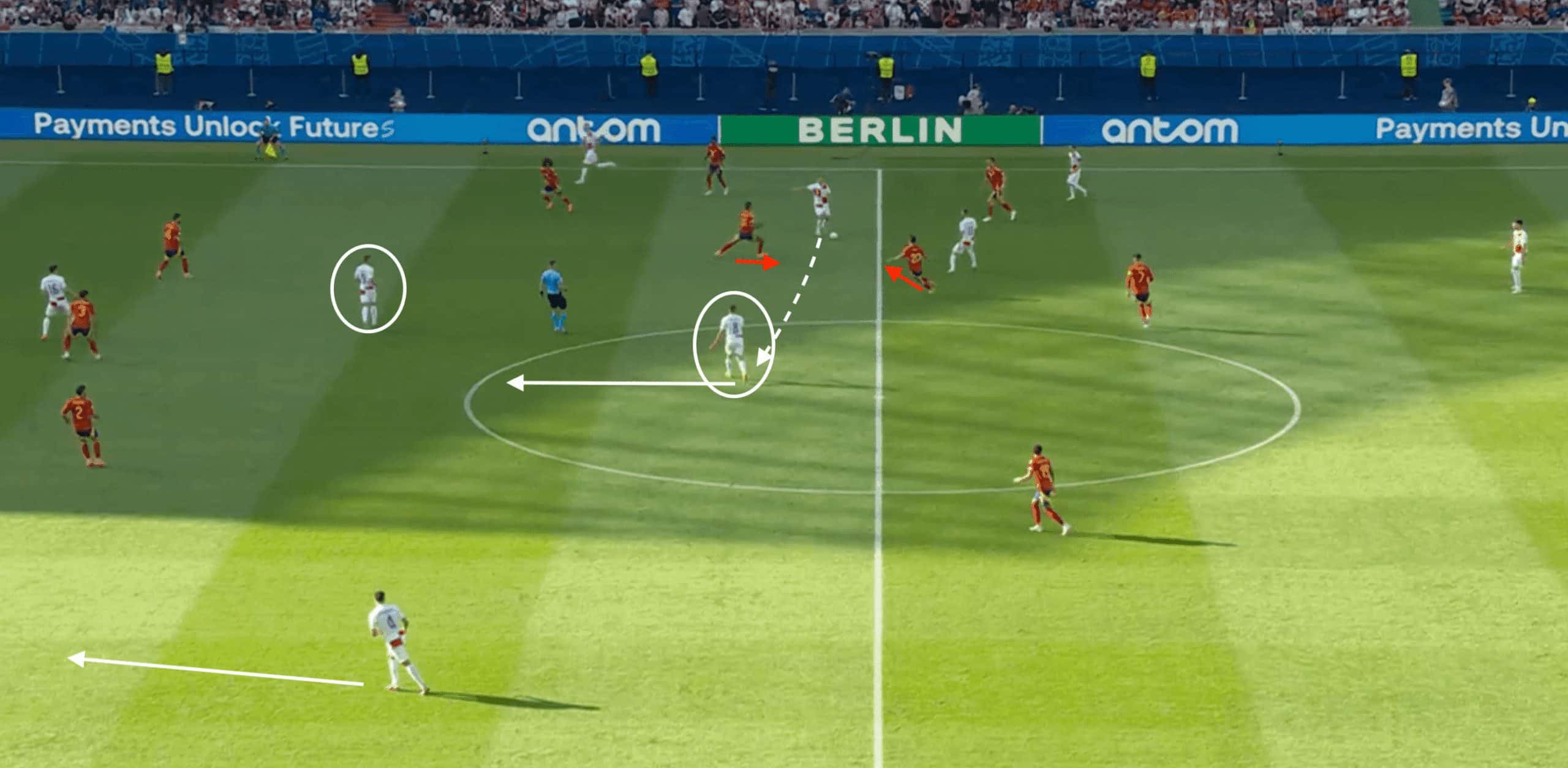
This also drew the Spanish full-backs backs inside the pitch, subsequently reducing the width of their defensive lines and creating huge gaps out wide for Croatia to penetrate with their advancing full-backs.
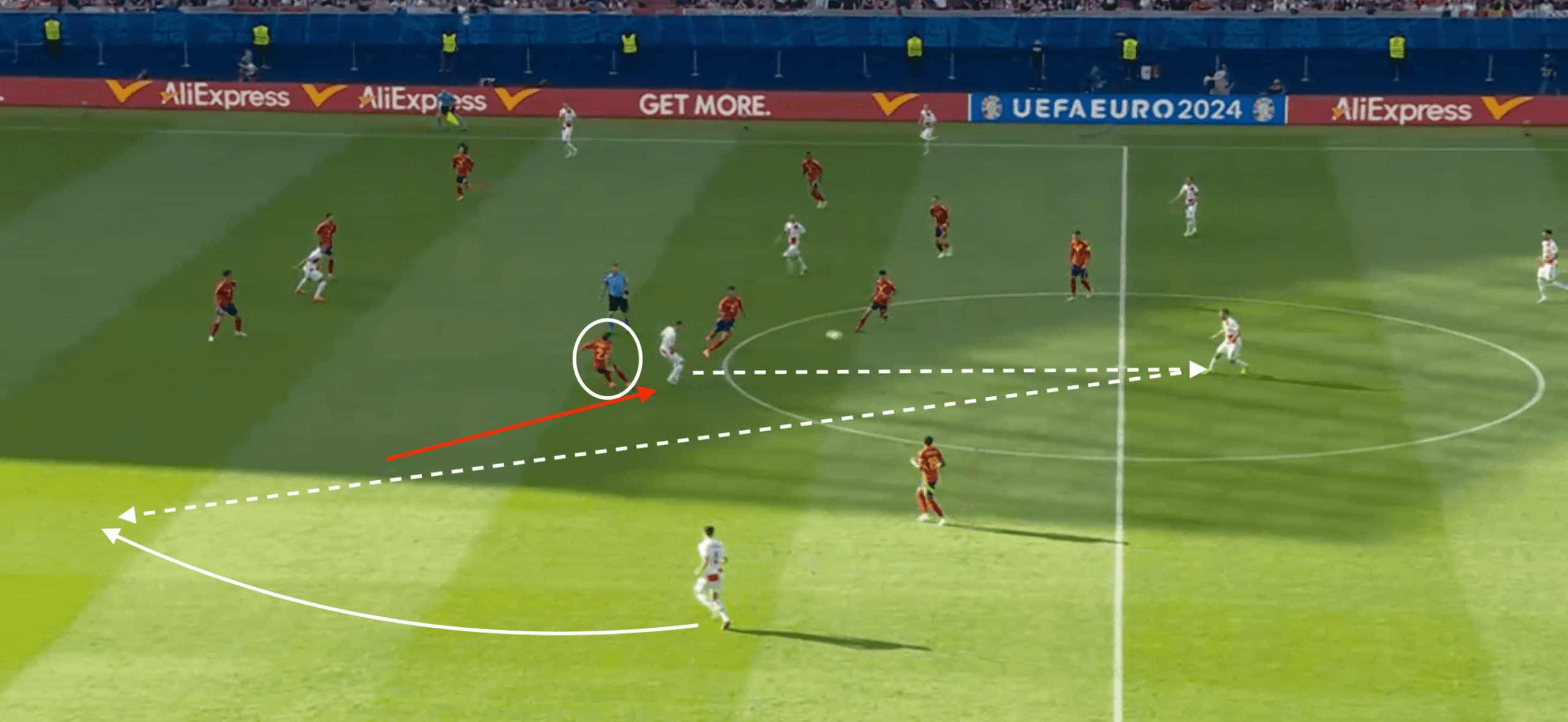
For all their talent in the final third, Spain’s wingers lack the sufficient amount of defensive contribution to combat opposition full-backs who enjoy marauding into their defensive third, with Williams, in this example, drawn into the centre of the pitch and neglecting Stanisic behind him.
In theory, this creates a huge dilemma for Cucurella, who now faces a 2v1 and either allows Majer to pick up an excellent position inside the pitch or allowed Stanisic to have free reign of the left flank.
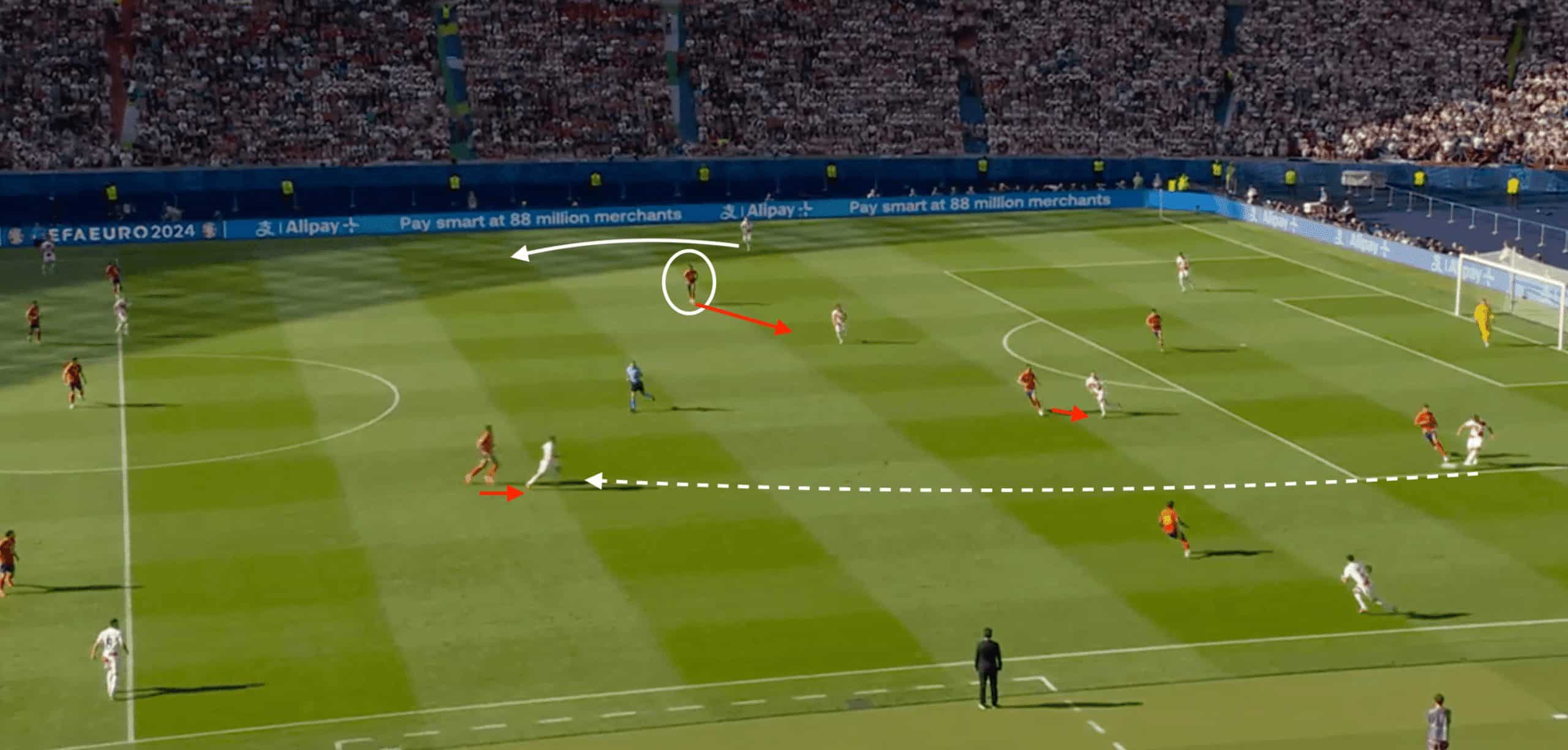
How can Georgia hurt Spain?
Even though they will head into their next match against Georgia as deserved favourites, it begs the question of whether this Georgian side could target some of the weaknesses in this crucial knockout clash.
Georgia has displayed a distinct lack of caution thus far, exciting fans with their attacking desire after a huge 2-0 win over Portugal, proving that they are unfazed by a more dominant opponent.
With key man Khvicha Kvaratskhelia picking up important positions through the left half-space, it would be fair to assume that this will force Dani Carvajal to shadow the winger as he drifts centrally to link play, much like we saw in his matchup with Kramarić.
This once again creates the space on the left flank for the overlapping run of Georgia’s advancing wing-backs, with Tsitaishvili not hesitating at the opportunity to whip the ball into the penalty area.
With Kvaratskhelia the centre of attention on the left-hand side, the movement of Chakvetadze drifting across to the other flank is going to be equally as important in unlocking the Spanish defence.
As we have mentioned, Cucurella has been caught out in a numerical disadvantage on several occasions, especially with him being the more attack-minded Spanish full-back.
Therefore, it would be wise for Georgia to emulate those overloads with Chakvetadze playing closer to Kakabadze and subsequently allowing Mikautadze to drop in, creating effective attacking triangles.
The FC Metz striker leads this summer’s Golden Boot race and will garner increased defensive attention with his red-hot form.
Conclusion
Spain’s perfect start has not happened by chance, and the welcomed addition of youthful play has complemented their traditional values very nicely.
De la Fuente’s team certainly feel as though they are the ones to watch, even when acknowledging their tricky run to the final.
Despite being in such dominant form across these first group stage matches, it feels as though Spain is yet to find that next gear, exciting their supporters and striking fear into those who stand in their path.
But first, they must defeat a Georgian side with little to no expectations heading into the round of 16, full of attacking surprises and the opportunity to defeat another European giant.
Spanish supporters will take solace in the fact that their start to this tournament has emulated their more successful squads in decades gone by.





Comments